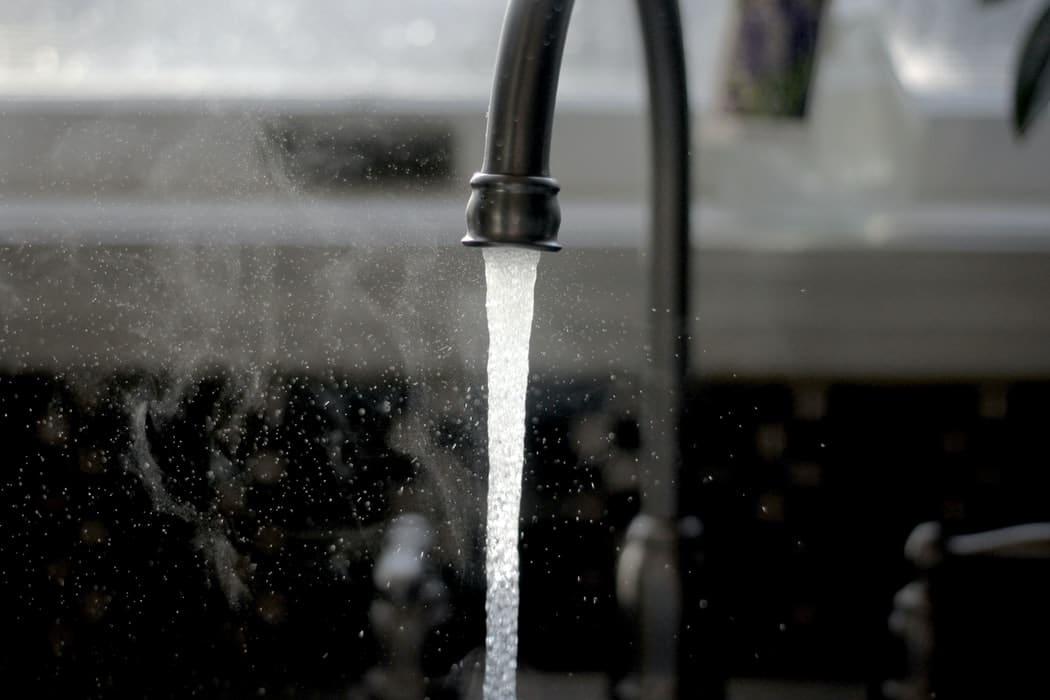There are several contaminants in tap water to be wary of, including but not limited to lead, viruses, bacteria, and other pollutants and chemicals that can cause illness and disease. The long list of what can be found also includes PFAS. But what are PFAS in water referring to?
The acronym is short for per-and polyfluoroalkyl substances, which are man-made chemicals that include PFOA (perfluorooctanoic acid), PFOS (perfluorooctanesulfonic acid), and GenX, among others. These types of chemicals are commonly referred to as “forever chemicals” because they do not break down, but rather accumulate over time. This means drinking from a water source contaminated with PFAS chemical or chemicals will build up in the system over time. Even if there are small amounts present, this accumulation can still pose a health risk.1
PFAS in drinking water are often linked to nearby facilities, such as a landfill or wastewater treatment plant, that seep these chemicals into the groundwater. However, exposure to PFAS also derives from food packaging, commercial household products, and workplace facilities that involve manufacturing of any kind. There are several ways people can be exposed to a PFAS chemical. Minimal amounts from multiple sources can still lead to adverse health effects with time.
Due to their high toxicity levels, many chemical manufacturers no longer use PFOA in their products or as emissions from their facilities. For decades, PFOA was commonly found in consumer goods, including carpet, textiles, cookware, plastics, and packaging. Due to the health risks PFAS, like PFOA, causes, it’s essential to remove them from water sources people rely on for drinking water. You should look into getting a water purifier for office to help combat the toxicity levels. Below, we cover treatment processes for those that are interested in knowing how to remove PFAs from water?
Water Treatment Processes for PFAS
The U.S. Environmental Protection Agency (EPA) has outlined several ways to remove PFAS concentration from drinking water.2 These methods include:
- Granular activated carbon treatment. PFAS sticks to small pieces of carbon as the water passes through, leaving the contaminants behind and fresh water to flow.
- Powdered activated carbon treatment. This is similar to the granular activated carbon process, except the carbon is in powdered form and added to the water to attract the chemicals to stick to the PFAS substance as the water passes through.
- Ion exchange resins. The hydrocarbon resin attracts PFAS like a magnet and removes them from the water.
- Nanofiltration and reverse osmosis. Water is pushed through membranes with a microscopic-sized pore to capture the chemicals and particles and allow the filtered water to pass through.
Each of these technologies is effective in removing PFAS from water, though each has varying degrees of success and operational accessibility. A city’s water system is responsible for ensuring public water supplies are healthy to drink. Every year, they must publish a Consumer Confidence Report that lists the types and amounts of contaminants found in tap water and how it compares with the limits regulated by the Centers for Disease Control and Prevention (CDC).
In addition to PFAS, there are several other harmful contaminants found in tap water, not all of which are removed from the treatment process listed above. Some chemicals and pollutants have immediate side effects, while others may manifest with time when there is a certain amount that’s accumulated in the body.
Adverse Health Effects Caused by PFAS
Since PFAS are found in a wide range of products, exposure is common, though not any less serious, especially if there is prolonged exposure from multiple sources. Research shows PFOA and PFOS can lead to reproductive and developmental problems, as well as affect the liver, kidney, and immune system. That said, it’s especially important for expecting mothers to know the impact of drinking tap water while pregnant.
For example, an extensive scientific review of the effects of PFAS provides supportive evidence that PFAS exposure has been linked with reduced kidney function, chronic kidney disease, and kidney cancer.3 Studies referenced in the review show the association between adverse kidney outcomes later in life, and low birth rates appear due to placental dysfunction as a result of PFAS exposure. Other adverse health conditions linked to PFAS include:
- Increased cholesterol levels
- Effects on the immune system
- Low infant birth weights
- Thyroid disruption
- Cancer
The concern about PFAS is largely due to the bioaccumulation and persistence in the environment with numerous sources people can be exposed to. PFAS were prevalent in consumer products through the early 2000s and have since been removed, but still are prevalent in products, places, and water sources.
PFAS Exposure Linked to Worse COVID-19 Outcomes
A recent study led by Harvard T.H. Chan School of Public Health showed an increased risk of more severe COVID-19 outcomes with those who had elevated blood levels of PFBA (Perfluorobutanoic acid). Researchers tested blood samples from 323 study participants infected with the coronavirus and found those with higher PFBA levels had higher odds of being hospitalized, admitted to intensive care, or mortality than those with lower levels.4
The cumulative effects that PFAS exposure has on the body makes it unpredictable for developing certain viruses, illnesses, and diseases, and seems to compromise the immune system in greater capacity than those with lower levels of PFAS in their system.
How the EPA Has Regulated PFAS in Drinking Water
In ongoing research and reporting on toxicity in water, the EPA has made efforts in informing the public of PFAS health advisories and steps taken to remove them from drinking water.5 These include:
- Establishing methods to measure for certain PFAS compounds in drinking water
- Identifying five treatment measures for PFOA and PFAS removal
- Issuing drinking water health advisories for PFOA and PFOS for water supply levels at 70 parts per trillion
It’s important to keep in mind, though, proactive efforts cannot reverse previous exposure of PFAS through contaminated water sources and other common areas where PFAS exposure is higher. Cities have water treatment system solutions created to remove common bacteria, pollutants, and contaminants. Then, there are at-home filtration processes the Centers for Disease Control and Prevention (CDC) recommends. All of which is designed to provide the cleanest possible water for people to drink at the tap.
Public Water System Treatment Solutions
Public drinking water supplies vary throughout the U.S. Though considered some of the safest in the world, there are certain regions that have a higher risk of PFAS contamination than others. When water supplies are close to agricultural land, manufacturing warehouses, and other facilities, there is a higher amount of toxic runoff made up of pesticides, herbicides, and chemicals that seep into the water.
Furthermore, some city pipelines are more outdated than others. Those made of lead or copper leach into the public water system and contaminate the water, resulting in urban water pollution. When deciding how to remove contaminants, including the PFAS concentration from water, most community water systems follow a water treatment process that includes:
- Coagulation and flocculation
- Sedimentation
- Filtration
- Disinfection
The water treatment process begins with coagulation and flocculation. This is a chemical-based process that adds a positive charge to the water to neutralize the negative charge of dirt and other dissolved particles that end up in water supplies. As this occurs, these particles bind with the added chemicals and form larger particles referred to as flocc.
After flocc has been produced, the next phase of water treatment is sedimentation, where the heavier particles settle to the bottom of the water supply. After the flocc has been separated from the water, the clear water on top is passed through filters of varying pore sizes. They are designed to capture the smallest contaminants, such as bacteria, viruses, parasites, and chemicals.
To round out the process, most public water systems use chlorine or chloramine to disinfect the water, killing off any remaining harmful organisms that may have slipped through the filters and ended up in the final stage. This process also protects the water from germs as it flows from the main public water system and into businesses and homes.6
While a city’s public water treatment process is thorough, it still isn’t able to capture the various pollutants that still end up in tap water. Additionally, depending on the level of disinfectant, water can have a chlorine-like smell and taste, which isn’t appealing to drink. To eliminate these common problems, FloWater presents an advanced purification process that transforms tap water.
FloWater’s Advanced Purification Process
FloWater’s advanced purification process in their water bottle refill stations go through steps similar to public water treatments, but takes it a step further. It, too, starts out with a sediment phase to capture the larger particles, like dirt, dust, and rust that end up in tap water. From there, the water enters carbon filters that remove the smaller particles, odors, and tastes that may linger, often caused by hydrogen sulfide or heavy metals.
Plus, if you are asking, does tap water have fluoride in it? Yes, it does, and the final purification filter uses advanced osmosis, which captures the tiniest particles by a semipermeable membrane to remove any lingering contaminants, such as fluoride, lead, viruses, pesticides, and other dissolved solids. The entire process removes up to 99% of impurities found in typical tap water.
Then, to make it healthier and more enjoyable, the last four filters of the process add back healthy elements to improve the water’s taste, smell, and drinkability. The activated oxygen filter self-sanitizes the system tanks that destroy viruses and bacteria.
Following that, a proprietary blend of trace minerals are added to the water to raise the pH balance and neutralize acidity in the body, which is caused by a variety of daily factors and can cause stress on the internal organs. These are also effective methods in preventing any adverse health effects of lead in drinking water.
Finally, in the last two purification stages, electrolytes are added to the water. Plus, the water goes through coconut carbon filters to support healthy body functions and improve the taste. The result is crisp, refreshing water dispensed at the optimal drinking temperature for every single person.
People are conscientious about what they consume now more than ever. Since water is the main source of hydration, it’s important they know where it comes from and how it’s treated to ensure they’re drinking the purest water available that consistently tastes great.
For more information about how FloWater can support your business, submit a quote today!
Sources:
- “Basic Information on PFAS.” U.S. Environmental Protection Agency. https://www.epa.gov/pfas/basic-information-pfas
- U.S. Environmental Protection Agency. Treating PFAS in Drinking Water. https://www.epa.gov/pfas/treating-pfas-drinking-water
- Blake, Bevin E. and Fenton, Suzanne E. Toxicology, October 2020. Early life exposure to per- and polyfluoroalkyl substances (PFAS) and latent health outcomes: A review including the placenta as a target tissue and possible driver of peri- and postnatal effects. https://www.ncbi.nlm.nih.gov/pmc/articles/PMC7530144/#R8
- Harvard T.H. Chan School of Public Health. PFAS exposure linked with worse Covid-19 outcomes. https://www.hsph.harvard.edu/news/hsph-in-the-news/pfas-exposure-linked-with-worse-covid-19-outcomes/.
- EPA. PFAS: What You Need to Know. https://www.epa.gov/sites/production/files/2018-03/documents/pfasv15_2pg_0.pdf
- Centers for Disease Control and Prevention. Water Treatment. https://www.cdc.gov/healthywater/drinking/public/water_treatment.html





